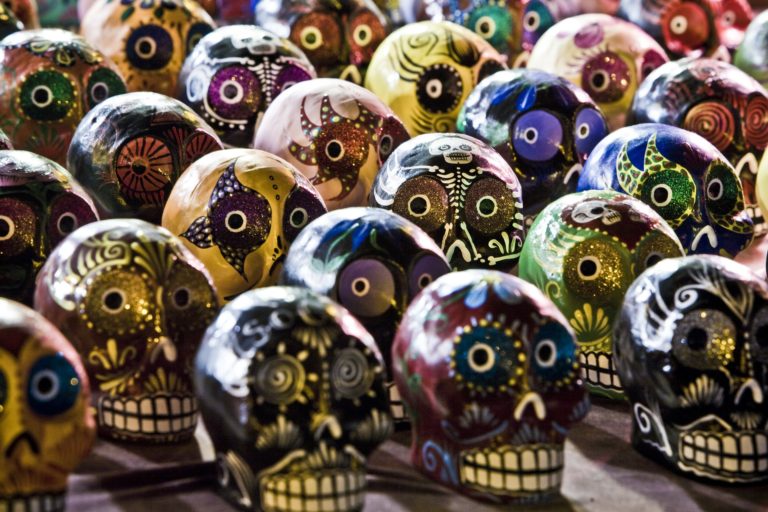The Day of the Dead celebrations may coincide with Halloween and seem similar. Both celebrations involve costumes, skeletons, and treats as well as graveyards and death imagery.
But there are some big differences.
The Day of the Dead holiday (in Spanish referred to as Dia de los Muertos), originated in Mexico and celebrates the dead, rather than being afraid of the dead. It’s a holiday for people to honor their ancestors and loved ones who have passed away and invite those spirits back into their homes to be part of the family once more. It’s a celebration of family and a show of respect for those who have passed away.
The practice of celebrating the dead goes back thousands of years in Latin American cultures. In the Aztec culture the celebration of the dead was in August and went on for a month.
Rather than displaying grim or gory decorations, Day of the Dead celebrations involve paying respects to loved ones. Families tend graves and leave offerings, plant flowers and trees, wear the clothes of their deceased relatives, and build altars in their homes to honor their loved ones.
Perhaps the most popular part of the holiday is people turning themselves into skeletons using elaborate makeup and masks. The skeletal appearance highlighted with flowers, bright colors and artwork is a striking image that has now become an icon of the Day of the Dead. These looks are based partly on the decorated sugar skulls that are left on altars as offerings to the spirits.
Here’s a quick look at some of the differences between the two days:
The Day of the Dead (Día de Muertos) |
Halloween |
|
| Dates Celebrated | Between October 28 and November 2 | October 31 |
| Origins | Originated in Mexico and celebrated throughout Latin America | Originated with the ancient Celtic festival of Samhain |
| Purpose | To celebrate, honor, and remember deceased loved ones. | It began as a festival to ward off ghosts and has evolved into a night of costumes, parties, and trick-or-treating. |
| Symbols | Sugar skulls The ofrenda (the altar that contains photographs and other objects of departed loved ones) The cempasúchil (a type of marigold flower that is grown in Mexico) Monarch butterflies (believed to house spirits of those who have died) |
Pumpkins (Jack-O’-Lanterns) Witches Spiders Black cats Skeletons Ghosts Candy Orange and black colors |
| Costumes | Participants dress up as skeletons and paint their faces to look like colorful skulls. They may wear suits or fancy dresses and carry noisemakers. | Costumes vary and can be trendy, but traditional Halloween costumes include: Witch Scarecrow Pumpkins Mummy Skeleton |
| Foods | Pan de muerto (bread of the dead) Sugar skulls Tamales Favorite foods of the late family members |
Candy (traditionally candy corn) Pumpkin pie Caramel and candy apples Apple cider |
I must say that I much prefer Day of the Dead celebrations to Halloween in my older age. Part of it is that I’ve grown more disturbed by the evolution—or perhaps devolution—of Halloween decorations into what are sometimes quite offensive portrayals of horror. But I have a daughter who delights in dressing up, attending the town parade and indulging in candy. I do enjoy those innocent pleasures. So I will happily take my 8-year-old daughter through our neighborhood to ask for candy on Halloween. But I will also honor the memory of my mother in the coming days.
Will you celebrate anyone? What are your family’s traditions around Day of the Dead and Halloween?
This post originally appeared on the ThinkTank12 blog and has been revised in 2017 and 2018.





































